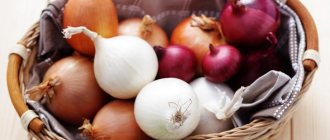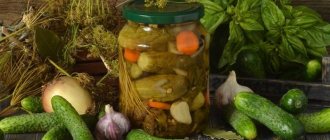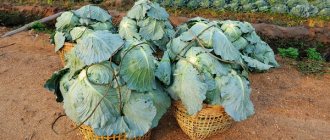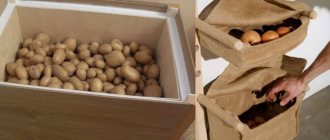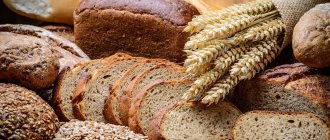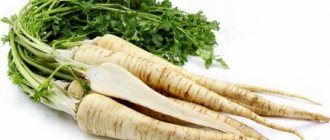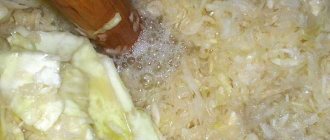Regardless of the time of year, you can buy almost any vegetables and fruits in stores. And in order for these products to retain their presentation, freshness and maximum vitamins, you need to adhere to the rules for their storage. In this article, I will share with you my experience of storing vegetables and fruits in the refrigerator, pantry and on the balcony, and also tell and show you little tricks that help protect food from spoilage.
To prevent vegetables and fruits from absorbing each other’s smell, they should be stored separately (on different shelves of the refrigerator, in special containers, boxes, bags, etc.).
Potato
It is best to store potatoes in a dark, cool place with good air circulation. To prevent sprouts from appearing on the tubers, put 2-3 apples in a bag or box with potatoes. The apple absorbs moisture faster and the potatoes will not germinate. My potatoes are stored on the balcony in a plywood box insulated with foam plastic. When there is severe frost outside, I cover the box with a sheepskin coat.
It is not advisable to store potatoes in the refrigerator, because moisture and cold negatively affect the taste of the tubers.
What affects the shelf life
You can determine how long the shelf life will be, taking into account some important factors specified in the rules and regulations of SanPiN 2.3.2.1324-03 :
- Temperature conditions affect the classification of products into perishable and especially perishable categories. At low temperatures, the development of pathogenic microflora slows down. Stable low temperatures without sudden changes will prevent the development of fungus.
- Humidity levels affect quality. Air humidity prevents vegetables from losing their elasticity and does not allow the root crops’ own moisture to evaporate.
- Air exchange prevents excess moisture from accumulating and provides an influx of fresh air.
- The type and material of packaging will affect the safety of finished dishes.
- The grade of a crop is a necessary condition for suitability for long-term storage. Varieties intended for immediate consumption after preparation cannot be stored for a long time.
Pumpkin
I also keep a pumpkin on the balcony. I have it insulated, and the temperature in not too cold winters stays within 10-12 degrees. I covered the floor with paper, laid out the pumpkin and covered it with a dark blanket. After all, it is also advisable to store it in a dark place where direct sunlight does not reach. But since January of this year turned out to be very frosty, I moved the pumpkin into the room and placed it in the corner near the balcony, naturally, away from the radiator. If I left the pumpkin on the balcony, where the temperature dropped to 0-2 degrees, or maybe lower, the orange beauty would begin to turn black and rot.
Cabbage
I store white and blue cabbage in a cool place, wrapping the heads in paper. I don’t remember where I heard this advice, but I liked the fact that it almost doesn’t spoil (the top leaves dry out a little). And so that it does not take up much space in the refrigerator, I put it on the balcony, wrapping each head of cabbage in paper. Do not use newspapers; the ink from printing can be absorbed into the vegetable, and consuming such products is very dangerous.
In what containers can it be stored?
There are several options for suitable containers for storing fruits and vegetables:
- Plastic bag. The most common option. Suitable for short-term storage up to 2 weeks. Can be kept slightly open for ventilation.
- Paper bag or towel. It is convenient to place fruits in paper in a dry place for a long time: potatoes, pomegranates, onions, etc. It is convenient to put berries and mushrooms in the refrigerator this way. But for a period of no more than 3 days.
- Cling film. You can wrap any product with it, the main thing is that moisture does not accumulate inside, otherwise it will begin to rot quickly. Best suited for leafy greens, citrus fruits and root vegetables.
- Plastic containers. Vegetables and fruits can be stored in specially designed plastic containers for up to a month.
Onion
I store onions of different varieties (Yalta or red, shallots, onions) separately from each other. The room should be dark, dry and cool (temperature no higher than 18 degrees). I have a separate large basket for onions; the air is well ventilated in it, and I can always quickly select the desired size of onion. I’m not a fan of hanging onions in nylon tights or nets; it’s not very convenient to get them out of there. I have these baskets in my pantry.
Carrot
I never wash carrots; I store them the way they were dug up in the garden, that is, in the ground, sand or clay. The fact is that carrots have thin skin and by washing the vegetable, you shorten its shelf life. Carrots are perfectly stored in the refrigerator in a plastic bag at a temperature of +2 - +5 degrees for two to three weeks.
If you have a private house, basement or cellar, then do not be lazy to make a box with sand for the carrots and store it in it (completely immersing the carrots in the sand; with this storage, the carrots, after being removed from the sand, are no different from those just dug up in the garden) .
Beet
Beets are perfectly stored in any cool place: the bottom shelf of the refrigerator or vegetable compartment, balcony, basement or cellar. Store it in a box, bag or bag. If I buy a lot of beets, I store some in the refrigerator, some on the balcony. The main thing is to protect the vegetable from direct sunlight.
I store radish, celery root, and horseradish root in the same way.
By the way, root vegetables cannot be stored cut, because this way they quickly deteriorate, dry out and rot. If you have half a beet, part of a carrot or celery root left and nowhere to use them, freeze the vegetables. Cut into cubes, strips or grate, put in a bag and put in the freezer. In the future, when cooking soup or stewing a dish, you will have a useful preparation.
Reminder for storing vegetables
Potato
Where and how to store potatoes: Potatoes do not tolerate long-term storage in the refrigerator, since at low temperatures starch begins to turn into sugar. But potatoes love dark (in the light they become tasteless and even toxic), cool (+5°C to +7°C) and dry (no more than 85% humidity) places. Therefore, cellars, storage rooms, insulated garages or balconies are best suited for storing large stocks. Small supplies of potatoes can be stored in an apartment in a kitchen cabinet or, say, under the sink. A week's supply of potatoes can live on the bottom shelf of the refrigerator. Before storing the tubers, you need to sort them out, leaving only healthy and strong potatoes (winter stocks should be sorted out 2 more times during the winter).
Time frame: 3 weeks in an apartment, and up to 5-6 months in ideal conditions.
cucumbers
Where and how to store cucumbers: in the refrigerator.
Time frame: 5 days.
Tomatoes
Where and how to store tomatoes: at room temperature, for example on a countertop or in a cupboard. Tomatoes cannot be stored in the refrigerator - at temperatures below 10 degrees they lose their aroma and become tasteless. If you need to store tomatoes for more than three days, then you can put them on the bottom shelf of the refrigerator, and then restore the aroma and taste by keeping the fruit at room temperature for about 1 day.
Terms: 3 days – optimal shelf life for ripe tomatoes.
Tip: To ripen unripe tomatoes, keep them in a paper bag at room temperature (see photo below).
Garlic
Where and how to store garlic: Garlic can be stored in a cabinet or on a countertop, in a pantry or cellar. The main thing is that air circulates freely around it. Garlic cannot be stored in the refrigerator, as at low temperatures it quickly loses its aroma and taste.
Time frame: 2 months.
Onion
Where and how to store onions: Onions can also be stored in a closet or on a countertop, in a pantry or cellar. The main thing is that air circulates freely around it.
It is best to store onions in mesh bags (which they are often sold in in stores) to get this ventilation. If there is no mesh, you can place the bulbs in a bowl and, if desired, cover them with a breathable cloth, but not with a lid.
It is not advisable to store whole onions in the refrigerator, but it is better to store chopped onions there and for no more than 4 days.
Time frame: 2 months.
Cabbage (white and red)
Where and how to store cabbage: in the refrigerator, on any shelf.
Time frame: 2 weeks.
Brussels sprouts, savoy sprouts, Chinese sprouts, cauliflower
Where and how to store: in the refrigerator.
Time frame: 1 week.
Carrot
Where and how to store: in the refrigerator.
Time frame: 2 weeks.
Sweet pepper
Where and how to store peppers: in the refrigerator, away from other vegetables.
Timing: 1 week (green pepper); 5 days (red, yellow and orange peppers).
Chili pepper (fresh)
Where and how to store: in the refrigerator.
Time frame: 2 weeks.
Note: Dried chilies will keep for 4 months in an airtight container.
Broccoli
Where and how to store broccoli: in the refrigerator, on any shelf.
Time frame: 1 week.
Beetroot and its tops
Where and how to store beets: in the refrigerator. Before storing in the refrigerator, the tops (which are very useful, by the way) need to be cut off and placed separately in a plastic bag.
Time frame: 3 weeks, tops – 3 days.
Eggplant
Where and how to store eggplants: in the refrigerator.
Time frame: 5 days.
Zucchini, zucchini and pumpkins
Where and how to store zucchini: in the refrigerator, cellar or other dry, dark and cool place.
Time frame: 5 days.
Avocado
Where and how to store avocados: in the refrigerator.
Time frame: 3 days.
Tip: To ripen an unripe avocado, keep it at room temperature in a paper bag until soft.
Artichokes
Where and how to store: in the refrigerator.
Time frame: 1 week.
Ginger
Where and how to store ginger: in the refrigerator.
Time frame: 3 weeks.
Tip: Ginger can be frozen for up to 6 months. If you want to grate the ginger, you don't have to defrost it.
Mushrooms
Where and how to store mushrooms: in the refrigerator, preferably in a paper bag.
Time frame: 1 week.
Turnip
Where and how to store turnips: in the refrigerator.
Time frame: 2 weeks.
Tip: Turnip leaves are very useful, so they are often used to prepare medicinal decoctions. Separate the tops from the root crop and store them separately in a plastic bag. The leaves will remain fresh for 3 days.
Radish
Where and how to store radishes: in the refrigerator.
Time frame: ideally up to 3 days, but 2 weeks is possible.
Tip: Remove leaves from root vegetables to prolong their freshness.
Asparagus
Where and how to store: in the refrigerator. Before storing, you need to trim the ends of the asparagus (see photo), and then wrap it in a damp towel and put it in a plastic bag.
Time frame: 3 days.
Leek
Where and how to store: in the refrigerator. Before storing, cut off and discard the dark green tops of the leeks, leaving the roots intact (see photo).
Time frame: 1 week.
Mustard
Where and how to store: in the refrigerator.
Time frame: 3 days.
Okra
Where and how to store: in the refrigerator, in a paper bag.
Time frame: 3 days.
Peas, English and snap peas
Where and how to store: in the refrigerator, leaving the pods until consumed.
Time frame: 4 days.
Rhubarb
Where and how to store: in the refrigerator.
Time frame: 1 week.
Tip: Rhubarb leaves are not recommended to be eaten in large quantities as they can be toxic.
Swede
Where and how to store: in the refrigerator or in the closet.
Terms: 1 week – at room temperature, 2 weeks – at low temperature.
Apples
I store apples in a cool place. I feel more comfortable on the balcony. You can also put it in the refrigerator, but then there is no room left for other products. It is very convenient to store apples in a cardboard box, box or basket, separating them with plain paper so that rot or spoilage does not spread to other fruits. If the volume of apples is small, less than 3-4 kg, then paper may not be used.
Reminder for storing herbs and greens
Greens (parsley and dill)
Where and how to store greens: in the refrigerator. Small bunches can be stored in glasses of water as bouquets (see photo).
Time frame: 5 days.
Shallot onion
Where and how to store shallots: Can be stored in a cupboard or on a countertop, in a pantry or cellar. The main thing is that air circulates freely around it.
Time frame: 1 month.
Spinach
Where and how to store: in the refrigerator.
Tip: No matter what the fresh leaves look like, follow the expiration date on the package as bacteria can develop.
Lettuce salad
Where and how to store: in the refrigerator.
Time frame: 5 days.
Tip: Even if the leaves look fresh, follow the expiration date on the package.
Watercress
Where and how to store: in the refrigerator.
Time frame: 4 days.
Celery
Because celery is porous, it is especially vulnerable to absorbing odors from other foods.
Where and how to store: in the refrigerator.
Time frame: 2 weeks.
Leafy herbs (basil, cilantro, green onions, tarragon, parsley, mint)
Where and how to store greens: in the refrigerator.
Time frame: 3 days (basil, cilantro, green onions, tarragon); 5 days (parsley, mint).
Tip: Wrap a bunch of greens in a damp paper towel before storing to keep them fresh longer.
Woody herbs (rosemary and thyme)
Refrigerator: 2 weeks.
Arugula
Where and how to store: in the refrigerator.
Time frame: 5 days.
Radicchio salad
Where and how to store: in the refrigerator.
Time frame: 4 days.
Tomatoes
I never store tomatoes in a special compartment with other vegetables. And in general I don’t put it in the refrigerator. For some reason, after being in the refrigerator, tomatoes become tasteless. So I store them in a container with holes on the kitchen cabinet shelf. By the way, it’s cool in my kitchen, the temperature is between 18-19 degrees.
I also don’t buy large quantities of tomatoes; I always try to use them in a salad or dish so that they don’t sit out for a long time.
Freezing vegetables
Buy and freeze vegetables instead of buying them frozen
Unfortunately, most frozen fruits and vegetables you find at the grocery store are packaged in plastic bags. To reduce your plastic use, buy and freeze your own vegetables. You can freeze almost any vegetable except eggplant, lettuce, mashed potatoes, radishes and sprouts.
- The only downside to freezing your own vegetables is that you will only be able to buy seasonal vegetables.
- For vegetables that need to be frozen, look for them that are young and tender.
Wash vegetables before freezing them
Make sure all vegetables are completely washed and dried before preparing them for long-term storage. Place broccoli, Brussels sprouts, and cauliflower in a bowl of water with 1 teaspoon (4.9 ml) salt for 15 minutes to remove any bugs that may be hiding inside.
- Depending on how you plan to cook the vegetables, you may not need to dry them completely before moving on to the next step.
Trim or chop vegetables before freezing
Remove or trim ends of vegetables, remove tops, discard inedible stems or leaves, remove peels, and remove skins. You can also cut the vegetables into small pieces.
Dip them in boiling water to blanch them.
Heat a large pot of water on the stove. Place the vegetables in boiling water and stir with a wooden spoon. Cover the pan with a lid and let the vegetables cook for the required amount of time.
- For best results, blanch the vegetables for the required time, which ranges from 1 to 10 minutes.
- Do not blanch the following vegetables; There are other cooking methods that should be used before freezing them: beets, garlic, herbs, mushrooms, onions, bell peppers, spaghetti, tomatoes.
Refrigerate vegetables after blanching
Using a wooden spoon or slotted spoon, remove the vegetables from the boiling water and place them in a large bowl of ice water. Ice water will instantly stop the cooking of vegetables.
- Vegetables should not be left in ice water for long periods of time.
- The vegetables can remain in the ice water until you are ready to move on to the next step.
Drain and place in a container with a lid
Use a colander to remove the vegetables from the ice water. Place them on a towel to dry or place them in a salad container. Place vegetables in a resealable container or reusable bag. Then place the container or bag in the freezer and leave for up to 12 months.
- You can use glass or metal containers in the freezer or silicone bags.
Store correctly and be healthy!
Garlic
The biggest hassle I had was storing garlic. The fact is that until the New Year, garlic heads are stored perfectly in the refrigerator, on the balcony, and in the pantry. But January-February comes, and the garlic begins to sprout, the cloves wither, deteriorate and turn yellow. Whatever I tried.
Two methods helped: burn the place where the roots sprout over the burner and sprinkle the garlic cloves with salt or flour. I always have a jar like this in the refrigerator - it contains garlic cloves in their husks, sprinkled with flour. You can also peel the teeth, put the garlic in a jar and add vegetable oil. It turns out that time has already been saved on peeling the garlic, and the aromatic oil can be used for frying other products.
cucumbers
I like to eat cucumbers cold. But many argue that they cannot be stored in the refrigerator. Yes, if you store them in a closed bag, they spoil faster and become tasteless, and without the bag they quickly wither. I store them on the refrigerator door, putting them in a bag and opening it slightly so that the cucumbers can breathe. Why on the door? So this is the warmest place in the refrigerator with a temperature of about +8 degrees. I am satisfied with this result; the cucumbers do not wither and do not change their taste. This way I keep them for up to one week.
Don't buy more cucumbers than you plan for a salad or other dish. Cucumbers quickly wither, and it may turn out that you just wasted your money.
Lemons
Here, on the refrigerator door, I have lemons. To prevent them from spoiling, I don’t put them in a bag. As you can see, the cut lemon is lying cut side down on my saucer. To prevent the cut from drying out, I dip the lemon in sugar and place it on a plate. And if you need lemon for a savory dish, then I dip it in salt and also store it on a saucer, cut side down.
I most often store tangerines and oranges on the balcony. And when there are very few of them left, I put them on the refrigerator door without a bag.
Nuts
One thing I have a lot of is nuts. We collect the harvest in bags, so we want to keep everything intact and not spoiled. The best storage method is in a cool and ventilated place. No plastic bags, cans, or plastic containers. I store it on the balcony in a box.
I also have a lot of “drying”, and I have more than once fought with moths that flew out of bags of dried apples. And then I began to store it in the cold and always in a linen bag, in which I put several dry mint sprigs. The photo shows that the bag with the “drying” is hanging on the balcony in the corner above the nuts.
Despite all the tips and tricks for storing fruits and vegetables, you should remember that they are best consumed fresh, when they are at their healthiest and tastiest. Try to correctly calculate the amount of vegetables and fruits that you will need within two to three weeks.
I hope my article was useful to you.
How to properly store vegetables and fruits in the refrigerator at home
The first place most groceries go is the refrigerator. But simply putting them on shelves is not enough. You need to know which vegetables and fruits can be stored in the refrigerator and which cannot, how to prepare them correctly, and which shelves to put them on.
Not all vegetables and fruits are suitable for storing in the refrigerator. Most fruits can be kept in the cold, so it’s easier to indicate those that are not advisable to store in this way:
- Grenades. They deteriorate faster, starting to mold from the inside. It is better to keep them warm by wrapping them in paper.
- Persimmons and bananas. They quickly begin to turn black. At first, this does not affect their internal state and taste, but then they soon begin to deteriorate.
- Melon and watermelon. Spoils the taste.
- Citrus. They reduce the shelf life of other fruits, so be sure to keep them in separate containers. It is advisable to store them in a dry place and put them in the refrigerator for a short time before use.
- Potato. Absorbs moisture and can freeze if the temperature is not maintained. It is better to put it in a cool, dark and dry place.
- Pumpkin. It begins to turn black and deteriorate. Need room temperature and a place without moisture.
- Onion and garlic. Cold and moisture are destructive for them. Need a warm and dry place.
You can keep other fruits and vegetables in the refrigerator.
